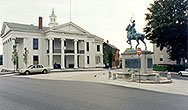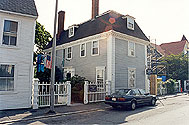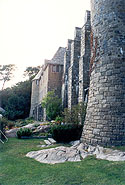
![]()
|
|
GloucesterThe town of Gloucester seems to form the second main inspiration for Lovecraft's Innsmouth. S. T. Joshi and David E. Schultz state that "Lovecraft has clearly drawn upon both the topography of the town and some specific features in it for Innsmouth." After departing the Sleeper-McCann House, I went north on East Main and then followed Main Street into town, passing a factory area associated with the famous fish company Gorton's of Gloucester. I believe there is more than one tourist information center in Gloucester, but the booth I ran into first was at the west corner of Rogers Street and Harbor Loop. (Rogers Street is a street that briefly separates from Main to follow the shoreline more closely.) There, an incredibly tough and weathered-looking old woman scrawled lines on their throwaway map to show me how to get to places. |
|
Legion Memorial Building |
The downtown area has many intriguing old buildings, but Donovan Louck's Web pages mention only a couple of specifically Lovecraftian interest. At Washington Square, I found the Legion Memorial Building. Loucks, along with Joshi and Schultz, cite this as the probable inspiration for the Order of Dagon Hall. Apparently up to a few years ago it was suitably decayed looking, but currently is in beautiful condition, a grand white building with an overhanging roof held up by decorative columns. Like the Order of Dagon Hall, the Legion Memorial Building sits on a circular concourse. However, the center of this concourse is occupied by a corroded statue of Joan of Arc on a horse, rather than by the green area described in Shadow. |
Sargent House Museum |
From there, it was an easy walk to the Sargent House Museum, also known as the
Sargent-Murray-Gilman-Hough House mentioned by Loucks. The place therefore unites at least
two Innsmouthian names, and certainly looks like it would fit in well in Innsmouth. At the
moment, however, scaffolding obscured much of the front of the building. Apparently a
restoration, or at least a repainting, is underway. (Loucks tells me he no longer regards
this house as a specific inspiration for anything in Innsmouth, but just an instance of
the way common names recur in New England.)
I also checked out the Cape Ann Historical Museum. This museum features beautifully mounted exhibitions on a variety of subjects, including the local fishing and granite quarrying industries and a well-known marine painter named Fitz Hugh Lane. |
Hammond Castle
|
At this point I departed Gloucester, as I hoped to take in Marblehead as well before sunset. However, I stopped just west of Gloucester at the Hammond Castle Museum. Listen to this quotation from their brochure:
Remind you of anyone else we know? Anyway, John Hays Hammond, described as America's second-greatest inventor, was able to collect many antiquities in Europe and also to build this vast stone castle on the Massachusetts coast. The resulting structure is an awe-inspiring piece of architecture with enough vast turrets, drawbridged moats, columned walkways and quaint details to satisfy the most demanding medievalist. The idea of building a complete anachronism may sound tacky, but in this case the results speak for themselves and form their own justification. |
|
Contents Previous: Cape Ann Next: Marblehead Return to Cthulhu Mythos home page Send comments to jfm.baharna@gmail.com © Copyright 1997-2021 by Joseph Morales |
|